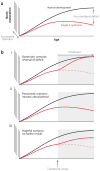Toward fulfilling the promise of molecular medicine in fragile X syndrome
- PMID: 21090964
- PMCID: PMC3100156
- DOI: 10.1146/annurev-med-061109-134644
Toward fulfilling the promise of molecular medicine in fragile X syndrome
Abstract
Fragile X syndrome (FXS) is the most common inherited form of mental retardation and a leading known cause of autism. It is caused by loss of expression of the fragile X mental retardation protein (FMRP), an RNA-binding protein that negatively regulates protein synthesis. In neurons, multiple lines of evidence suggest that protein synthesis at synapses is triggered by activation of group 1 metabotropic glutamate receptors (Gp1 mGluRs) and that many functional consequences of activating these receptors are altered in the absence of FMRP. These observations have led to the theory that exaggerated protein synthesis downstream of Gp1 mGluRs is a core pathogenic mechanism in FXS. This excess can be corrected by reducing signaling by Gp1 mGluRs, and numerous studies have shown that inhibition of mGluR5, in particular, can ameliorate multiple mutant phenotypes in animal models of FXS. Clinical trials based on this therapeutic strategy are currently under way. FXS is therefore poised to be the first neurobehavioral disorder in which corrective treatments have been developed from the bottom up: from gene identification to pathophysiology in animals to novel therapeutics in humans. The insights gained from FXS and other autism-related single-gene disorders may also assist in identifying molecular mechanisms and potential treatment approaches for idiopathic autism.
Figures



Similar articles
-
Excess phosphoinositide 3-kinase subunit synthesis and activity as a novel therapeutic target in fragile X syndrome.J Neurosci. 2010 Aug 11;30(32):10624-38. doi: 10.1523/JNEUROSCI.0402-10.2010. J Neurosci. 2010. PMID: 20702695 Free PMC article.
-
The state of synapses in fragile X syndrome.Neuroscientist. 2009 Oct;15(5):549-67. doi: 10.1177/1073858409333075. Epub 2009 Mar 26. Neuroscientist. 2009. PMID: 19325170 Free PMC article. Review.
-
Metabotropic glutamate receptors and fragile x mental retardation protein: partners in translational regulation at the synapse.Sci Signal. 2008 Feb 5;1(5):pe6. doi: 10.1126/stke.15pe6. Sci Signal. 2008. PMID: 18272470 Review.
-
Fragile X syndrome: loss of local mRNA regulation alters synaptic development and function.Neuron. 2008 Oct 23;60(2):201-14. doi: 10.1016/j.neuron.2008.10.004. Neuron. 2008. PMID: 18957214 Free PMC article. Review.
-
microRNAs and Fragile X Syndrome.Adv Exp Med Biol. 2015;888:107-21. doi: 10.1007/978-3-319-22671-2_7. Adv Exp Med Biol. 2015. PMID: 26663181
Cited by
-
Progress toward therapeutic potential for AFQ056 in Fragile X syndrome.J Exp Pharmacol. 2013 Jul 16;5:45-54. doi: 10.2147/JEP.S27044. eCollection 2013. J Exp Pharmacol. 2013. PMID: 27186135 Free PMC article. Review.
-
mGluR5 ablation in cortical glutamatergic neurons increases novelty-induced locomotion.PLoS One. 2013 Aug 5;8(8):e70415. doi: 10.1371/journal.pone.0070415. Print 2013. PLoS One. 2013. PMID: 23940572 Free PMC article.
-
Neuregulin 1-induced AKT and ERK phosphorylation in patients with fragile X syndrome (FXS) and intellectual disability associated with obstetric complications.J Mol Neurosci. 2014 Sep;54(1):119-24. doi: 10.1007/s12031-014-0257-z. Epub 2014 Feb 23. J Mol Neurosci. 2014. PMID: 24563264
-
Extinction of an instrumental response: a cognitive behavioral assay in Fmr1 knockout mice.Genes Brain Behav. 2014 Jun;13(5):451-8. doi: 10.1111/gbb.12137. Epub 2014 Apr 30. Genes Brain Behav. 2014. PMID: 24684608 Free PMC article.
-
Protein synthesis levels are increased in a subset of individuals with fragile X syndrome.Hum Mol Genet. 2018 Jun 15;27(12):2039-2051. doi: 10.1093/hmg/ddy099. Hum Mol Genet. 2018. PMID: 29590342 Free PMC article.
References
-
- Hyman SE. The role of molecular biology in psychiatry. Psychosomatics. 1988;29:328–32. - PubMed
-
- Kogan MD, Blumberg SJ, Schieve LA, et al. Prevalence of parent-reported diagnosis of autism spectrum disorder among children in the US, 2007. Pediatrics. 2009;124:1395–403. - PubMed
-
- Penagarikano O, Mulle JG, Warren ST. The pathophysiology of fragile X syndrome. Annu Rev Genomics Hum Genet. 2007;8:109–29. - PubMed
Publication types
MeSH terms
Substances
Grants and funding
LinkOut - more resources
Full Text Sources
Other Literature Sources
Medical
Research Materials

